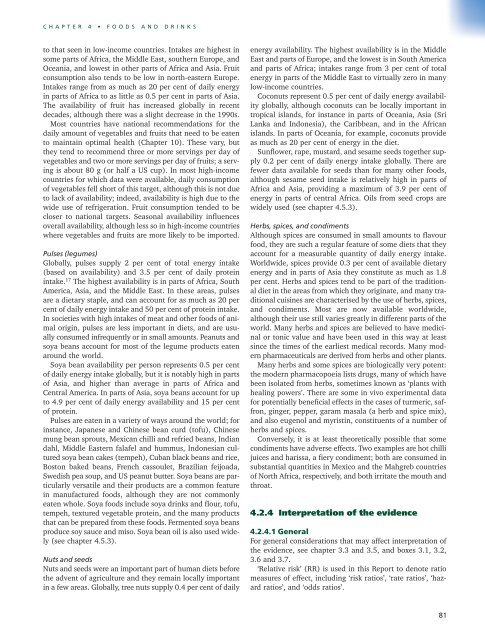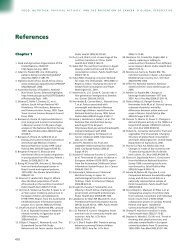Full Report - Food, Nutrition, and the Prevention of Cancer
Full Report - Food, Nutrition, and the Prevention of Cancer
Full Report - Food, Nutrition, and the Prevention of Cancer
Create successful ePaper yourself
Turn your PDF publications into a flip-book with our unique Google optimized e-Paper software.
CHAPTER 4 • FOODS AND DRINKS<br />
to that seen in low-income countries. Intakes are highest in<br />
some parts <strong>of</strong> Africa, <strong>the</strong> Middle East, sou<strong>the</strong>rn Europe, <strong>and</strong><br />
Oceania, <strong>and</strong> lowest in o<strong>the</strong>r parts <strong>of</strong> Africa <strong>and</strong> Asia. Fruit<br />
consumption also tends to be low in north-eastern Europe.<br />
Intakes range from as much as 20 per cent <strong>of</strong> daily energy<br />
in parts <strong>of</strong> Africa to as little as 0.5 per cent in parts <strong>of</strong> Asia.<br />
The availability <strong>of</strong> fruit has increased globally in recent<br />
decades, although <strong>the</strong>re was a slight decrease in <strong>the</strong> 1990s.<br />
Most countries have national recommendations for <strong>the</strong><br />
daily amount <strong>of</strong> vegetables <strong>and</strong> fruits that need to be eaten<br />
to maintain optimal health (Chapter 10). These vary, but<br />
<strong>the</strong>y tend to recommend three or more servings per day <strong>of</strong><br />
vegetables <strong>and</strong> two or more servings per day <strong>of</strong> fruits; a serving<br />
is about 80 g (or half a US cup). In most high-income<br />
countries for which data were available, daily consumption<br />
<strong>of</strong> vegetables fell short <strong>of</strong> this target, although this is not due<br />
to lack <strong>of</strong> availability; indeed, availability is high due to <strong>the</strong><br />
wide use <strong>of</strong> refrigeration. Fruit consumption tended to be<br />
closer to national targets. Seasonal availability influences<br />
overall availability, although less so in high-income countries<br />
where vegetables <strong>and</strong> fruits are more likely to be imported.<br />
Pulses (legumes)<br />
Globally, pulses supply 2 per cent <strong>of</strong> total energy intake<br />
(based on availability) <strong>and</strong> 3.5 per cent <strong>of</strong> daily protein<br />
intake. 17 The highest availability is in parts <strong>of</strong> Africa, South<br />
America, Asia, <strong>and</strong> <strong>the</strong> Middle East. In <strong>the</strong>se areas, pulses<br />
are a dietary staple, <strong>and</strong> can account for as much as 20 per<br />
cent <strong>of</strong> daily energy intake <strong>and</strong> 50 per cent <strong>of</strong> protein intake.<br />
In societies with high intakes <strong>of</strong> meat <strong>and</strong> o<strong>the</strong>r foods <strong>of</strong> animal<br />
origin, pulses are less important in diets, <strong>and</strong> are usually<br />
consumed infrequently or in small amounts. Peanuts <strong>and</strong><br />
soya beans account for most <strong>of</strong> <strong>the</strong> legume products eaten<br />
around <strong>the</strong> world.<br />
Soya bean availability per person represents 0.5 per cent<br />
<strong>of</strong> daily energy intake globally, but it is notably high in parts<br />
<strong>of</strong> Asia, <strong>and</strong> higher than average in parts <strong>of</strong> Africa <strong>and</strong><br />
Central America. In parts <strong>of</strong> Asia, soya beans account for up<br />
to 4.9 per cent <strong>of</strong> daily energy availability <strong>and</strong> 15 per cent<br />
<strong>of</strong> protein.<br />
Pulses are eaten in a variety <strong>of</strong> ways around <strong>the</strong> world; for<br />
instance, Japanese <strong>and</strong> Chinese bean curd (t<strong>of</strong>u), Chinese<br />
mung bean sprouts, Mexican chilli <strong>and</strong> refried beans, Indian<br />
dahl, Middle Eastern falafel <strong>and</strong> hummus, Indonesian cultured<br />
soya bean cakes (tempeh), Cuban black beans <strong>and</strong> rice,<br />
Boston baked beans, French cassoulet, Brazilian feijoada,<br />
Swedish pea soup, <strong>and</strong> US peanut butter. Soya beans are particularly<br />
versatile <strong>and</strong> <strong>the</strong>ir products are a common feature<br />
in manufactured foods, although <strong>the</strong>y are not commonly<br />
eaten whole. Soya foods include soya drinks <strong>and</strong> flour, t<strong>of</strong>u,<br />
tempeh, textured vegetable protein, <strong>and</strong> <strong>the</strong> many products<br />
that can be prepared from <strong>the</strong>se foods. Fermented soya beans<br />
produce soy sauce <strong>and</strong> miso. Soya bean oil is also used widely<br />
(see chapter 4.5.3).<br />
Nuts <strong>and</strong> seeds<br />
Nuts <strong>and</strong> seeds were an important part <strong>of</strong> human diets before<br />
<strong>the</strong> advent <strong>of</strong> agriculture <strong>and</strong> <strong>the</strong>y remain locally important<br />
in a few areas. Globally, tree nuts supply 0.4 per cent <strong>of</strong> daily<br />
energy availability. The highest availability is in <strong>the</strong> Middle<br />
East <strong>and</strong> parts <strong>of</strong> Europe, <strong>and</strong> <strong>the</strong> lowest is in South America<br />
<strong>and</strong> parts <strong>of</strong> Africa; intakes range from 3 per cent <strong>of</strong> total<br />
energy in parts <strong>of</strong> <strong>the</strong> Middle East to virtually zero in many<br />
low-income countries.<br />
Coconuts represent 0.5 per cent <strong>of</strong> daily energy availability<br />
globally, although coconuts can be locally important in<br />
tropical isl<strong>and</strong>s, for instance in parts <strong>of</strong> Oceania, Asia (Sri<br />
Lanka <strong>and</strong> Indonesia), <strong>the</strong> Caribbean, <strong>and</strong> in <strong>the</strong> African<br />
isl<strong>and</strong>s. In parts <strong>of</strong> Oceania, for example, coconuts provide<br />
as much as 20 per cent <strong>of</strong> energy in <strong>the</strong> diet.<br />
Sunflower, rape, mustard, <strong>and</strong> sesame seeds toge<strong>the</strong>r supply<br />
0.2 per cent <strong>of</strong> daily energy intake globally. There are<br />
fewer data available for seeds than for many o<strong>the</strong>r foods,<br />
although sesame seed intake is relatively high in parts <strong>of</strong><br />
Africa <strong>and</strong> Asia, providing a maximum <strong>of</strong> 3.9 per cent <strong>of</strong><br />
energy in parts <strong>of</strong> central Africa. Oils from seed crops are<br />
widely used (see chapter 4.5.3).<br />
Herbs, spices, <strong>and</strong> condiments<br />
Although spices are consumed in small amounts to flavour<br />
food, <strong>the</strong>y are such a regular feature <strong>of</strong> some diets that <strong>the</strong>y<br />
account for a measurable quantity <strong>of</strong> daily energy intake.<br />
Worldwide, spices provide 0.3 per cent <strong>of</strong> available dietary<br />
energy <strong>and</strong> in parts <strong>of</strong> Asia <strong>the</strong>y constitute as much as 1.8<br />
per cent. Herbs <strong>and</strong> spices tend to be part <strong>of</strong> <strong>the</strong> traditional<br />
diet in <strong>the</strong> areas from which <strong>the</strong>y originate, <strong>and</strong> many traditional<br />
cuisines are characterised by <strong>the</strong> use <strong>of</strong> herbs, spices,<br />
<strong>and</strong> condiments. Most are now available worldwide,<br />
although <strong>the</strong>ir use still varies greatly in different parts <strong>of</strong> <strong>the</strong><br />
world. Many herbs <strong>and</strong> spices are believed to have medicinal<br />
or tonic value <strong>and</strong> have been used in this way at least<br />
since <strong>the</strong> times <strong>of</strong> <strong>the</strong> earliest medical records. Many modern<br />
pharmaceuticals are derived from herbs <strong>and</strong> o<strong>the</strong>r plants.<br />
Many herbs <strong>and</strong> some spices are biologically very potent:<br />
<strong>the</strong> modern pharmacopoeia lists drugs, many <strong>of</strong> which have<br />
been isolated from herbs, sometimes known as ‘plants with<br />
healing powers’. There are some in vivo experimental data<br />
for potentially beneficial effects in <strong>the</strong> cases <strong>of</strong> turmeric, saffron,<br />
ginger, pepper, garam masala (a herb <strong>and</strong> spice mix),<br />
<strong>and</strong> also eugenol <strong>and</strong> myristin, constituents <strong>of</strong> a number <strong>of</strong><br />
herbs <strong>and</strong> spices.<br />
Conversely, it is at least <strong>the</strong>oretically possible that some<br />
condiments have adverse effects. Two examples are hot chilli<br />
juices <strong>and</strong> harissa, a fiery condiment; both are consumed in<br />
substantial quantities in Mexico <strong>and</strong> <strong>the</strong> Mahgreb countries<br />
<strong>of</strong> North Africa, respectively, <strong>and</strong> both irritate <strong>the</strong> mouth <strong>and</strong><br />
throat.<br />
4.2.4 Interpretation <strong>of</strong> <strong>the</strong> evidence<br />
4.2.4.1 General<br />
For general considerations that may affect interpretation <strong>of</strong><br />
<strong>the</strong> evidence, see chapter 3.3 <strong>and</strong> 3.5, <strong>and</strong> boxes 3.1, 3.2,<br />
3.6 <strong>and</strong> 3.7.<br />
‘Relative risk’ (RR) is used in this <strong>Report</strong> to denote ratio<br />
measures <strong>of</strong> effect, including ‘risk ratios’, ‘rate ratios’, ‘hazard<br />
ratios’, <strong>and</strong> ‘odds ratios’.<br />
81



